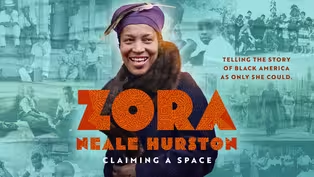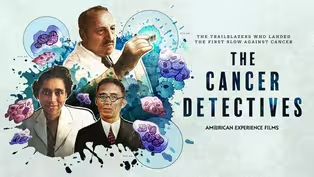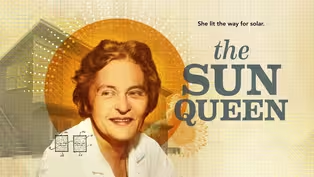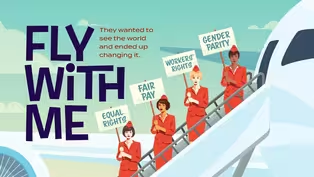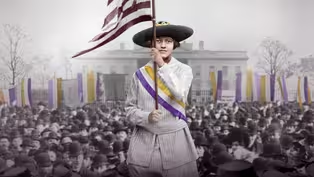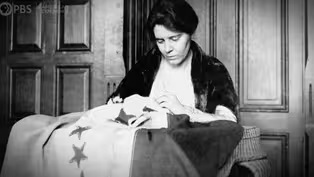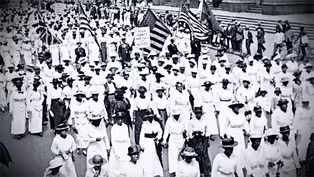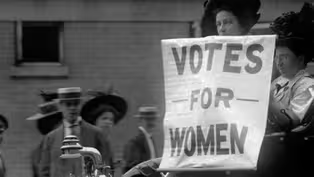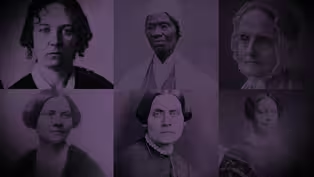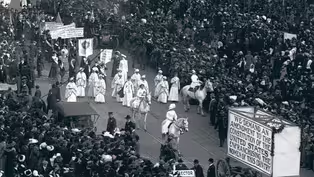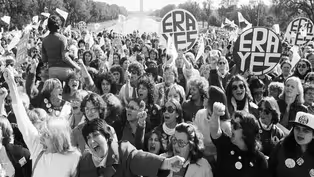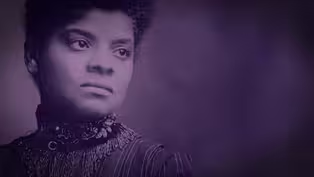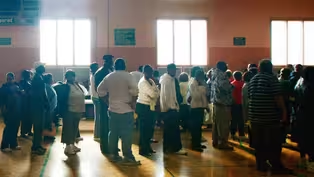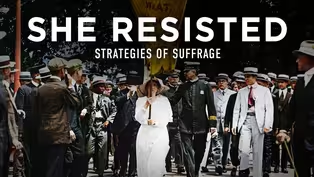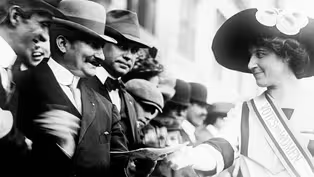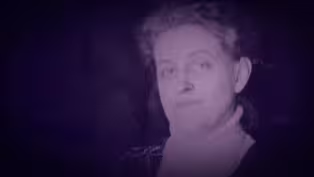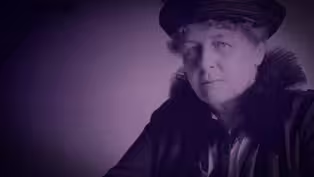
Part 1 | The Vote | American Experience
Season 32 Episode 9 | 1h 52m 42sVideo has Audio Description, Closed Captions
The fiery campaign that led to passage of the 19th Amendment, granting women the vote.
One hundred years after the passage of the 19th Amendment, The Vote tells the dramatic culmination story of the hard-fought campaign waged by American women for the right to vote, a transformative cultural and political movement that resulted in the largest expansion of voting rights in U.S. history.
See all videos with Audio DescriptionADProblems playing video? | Closed Captioning Feedback
Problems playing video? | Closed Captioning Feedback
Corporate sponsorship for American Experience is provided by Liberty Mutual Insurance and Carlisle Companies. Major funding by the Alfred P. Sloan Foundation.

Part 1 | The Vote | American Experience
Season 32 Episode 9 | 1h 52m 42sVideo has Audio Description, Closed Captions
One hundred years after the passage of the 19th Amendment, The Vote tells the dramatic culmination story of the hard-fought campaign waged by American women for the right to vote, a transformative cultural and political movement that resulted in the largest expansion of voting rights in U.S. history.
See all videos with Audio DescriptionADProblems playing video? | Closed Captioning Feedback
How to Watch American Experience
American Experience is available to stream on pbs.org and the free PBS App, available on iPhone, Apple TV, Android TV, Android smartphones, Amazon Fire TV, Amazon Fire Tablet, Roku, Samsung Smart TV, and Vizio.
Buy Now
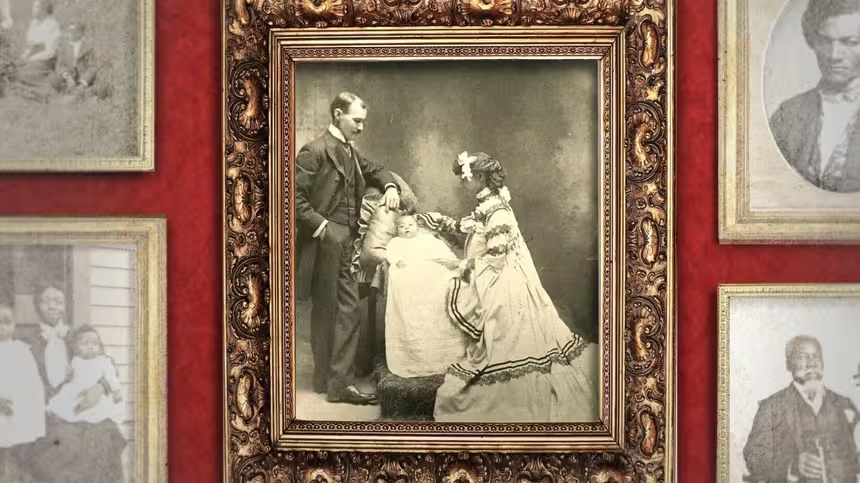
When is a photo an act of resistance?
For families that just decades earlier were torn apart by chattel slavery, being photographed together was proof of their resilience.Providing Support for PBS.org
Learn Moreabout PBS online sponsorshipMore from This Collection
In this collection, explore films, interviews, articles, image galleries and more for an in-depth look at notable female figures in American history.
Zora Neale Hurston: Claiming A Space
Video has Audio Description, Closed Captions
The influential author and anthropologist whose work reclaimed and honored Black life. (1h 52m 24s)
Video has Audio Description, Closed Captions
The untold story of the people who fought tirelessly to save women from cervical cancer. (52m 54s)
Video has Audio Description, Closed Captions
Unsung scientist Mária Telkes dedicated her career to harnessing the power of the sun. (52m 22s)
Video has Audio Description, Closed Captions
The lively but neglected history of the women who changed the world while flying it. (1h 52m 39s)
Part 2 | The Vote | American Experience
Video has Audio Description, Closed Captions
Part Two examines the mounting dispute over strategies and reveals the pervasive racism. (1h 52m 47s)
Providing Support for PBS.org
Learn Moreabout PBS online sponsorshipCROWD (chanting): Sisterhood is powerful!
Join us now!
Sisterhood is powerful, join us now!
Sisterhood is powerful, join us now!
Sisterhood is powerful, join us now!
WALTER CRONKITE: 50 years ago today, the 19th Amendment to the U.S. Constitution gave women the right to vote.
On this anniversary, a militant minority of women's liberationists was on the streets.
CROWD: Free ourselves!
(crowd chanting) REPORTER: So remember, men, if you come to work tomorrow and your secretary refuses to do the filing, and then go home and find that your wife has refused to do the cooking, don't blame them.
Remember, you gave them the vote 50 years ago.
(crowd chanting) NARRATOR: It had been the opening act in what proved to be an epic struggle for equality-- a crusade carried out by millions of women over the better part of a century to secure for themselves the right to vote, and thereby participate in America's democracy.
MARCIA CHATELAIN: To be disenfranchised is to be told that you do not matter, because the right to vote is about the power that governs your possibilities.
MICHAEL WALDMAN: The right to vote is the heart of democracy, and if half the country doesn't have the right to vote, you're nowhere near being a democracy.
PAULA GIDDINGS: Women would go out canvassing, and the men would be terrible to them.
They'd say, "Are you trying to wear the pants in the family?"
And, "This is male territory," and, "How dare these women begin to come in and make a difference."
(cannon booms) MARTHA JONES: This struggle is going on at the same time that the nation is resolving the Civil War.
So to introduce women is to disrupt a political culture that is built on exclusion, that is built on the notion that politics is a white man's business.
ELAINE WEISS: It's a civil rights battle.
We don't think of it like that, but it truly is a great civil rights battle.
Suffragists have to change the idea of what women's role in society will be.
What is her claim on citizenship?
ELEANOR SMEAL: The textbooks when I went to school said women were given the vote.
We weren't given anything.
We took it.
♪ ♪ NARRATOR: On June 29, 1909, a 24-year-old American student named Alice Paul made her way through the streets of London and joined a contingent of some 200 other women headed for the Houses of Parliament.
Once there, they planned to insist on an audience with the prime minister and press him for the right to vote, a fundamental exercise of citizenship, known as suffrage, that was then denied to women in most of the world's democracies.
ALEXANDER KEYSSAR: The right to vote is fundamental.
It's a key ingredient in letting people have equal voice and equal power.
It gives you a way to protect yourself.
And the opposite of it-- not having the right to vote-- in some political sense, leaves you helpless.
NARRATOR: When Alice Paul had arrived in England two years earlier, she'd had no thought of joining the crusade for woman suffrage.
She'd come, as she put it, to "see something of the world," and had enrolled in a graduate economics class at the University of Birmingham, the first woman ever to do so.
Then, one day on campus, she'd spotted a notice about an upcoming lecture.
The name was one she knew.
Christabel Pankhurst, along with her mother, Emmeline, was a co-founder of the Women's Social and Political Union, Britain's notoriously militant suffrage organization.
J.D.
ZAHNISER: Alice Paul had followed the Pankhursts with her mother in the newspaper.
They were getting a lot of newspaper coverage in America, and a lot of people were excited about what they were doing-- things that were so controversial that American women could not imagine them happening in America.
JAD ADAMS: There have been votes in the House of Commons since the 19th century in favor of women's suffrage, but there's no real progress taking place.
And so, in anger at this political stagnation, they actually start doing things which will get them sent to prison.
♪ ♪ ELLEN DUBOIS: They started with mass demonstrations-- demonstrations of 10,000, 20,000, 30,000 people demanding the right to vote.
TINA CASSIDY: They were passing out pamphlets on the street.
They were standing on literal soapboxes on the street corners of London and explaining why women deserved the right to vote.
At the time, standing on a soapbox on a street corner was something that only men did.
(woman speaking indistinctly, crowd clamoring) ZAHNISER: They would go to political meetings and they would interrupt politicians, which was considered extremely rude.
And they were literally dragged out of these meetings.
Nothing like this had ever been done before.
The idea was to really get enough attention in order to draw the members of Parliament, but also the public, into the cause of suffrage.
NARRATOR: So aggressive were the women of the Pankhurst army that a British journalist had concocted a twist on the term "suffragist" to identify them, derisively dubbing them "suffragettes."
DUBOIS: Ridicule is one of the great weapons against women's assertion, and that's what was going on with calling suffragists "suffragettes."
It minimized them.
It turned them into a small version of what they were.
NARRATOR: No amount of mockery in the press, however, had prepared Alice Paul for what happened at Christabel Pankhurst's lecture.
There were lots of male students from the University of Birmingham there, and they were hooting and hollering and singing songs and throwing things.
Someone threw a mouse, a dead mouse.
And it was total pandemonium.
ZAHNISER: Alice witnessed Christabel Pankhurst, who was no slouch on the speaking platform, essentially being shouted down and being unable to speak.
NARRATOR: Paul would remember it as a turning point.
PAUL (dramatized): I became from that moment very anxious to help in this movement.
You know if you feel some group that's your group is the underdog, you want to try to help-- it's natural.
And when I saw this outbreak of hostility, I understood everything about what the English suffragists were trying to do.
♪ ♪ MARY WALTON: Alice Paul was a Quaker.
Quakers believe that everyone is equal in the eyes of God, regardless of gender, regardless of race, regardless of religion.
ZAHNISER: Quakers believed in educating boys and girls equally, and so she had never experienced the reality of inequality.
And she began to realize that there was a whole other world out there where women were not necessarily treated equally.
NARRATOR: Some months after the lecture, Paul had written to her mother back home in New Jersey, "I have joined the suffragettes."
♪ ♪ Now she was marching with them to Parliament to demand for British women the right to vote.
WALTON: Emmeline Pankhurst leads the deputation up to the gates of Parliament.
And suddenly, they're stormed by police.
Women are thrown to the ground and they're trampled.
PAUL (dramatized): The scene was one awful nightmare.
The police grabbed the suffragettes by the throats and threw them flat on their backs over and over again.
Finally, when the police could not drive the women back or control the scene, the suffragettes were arrested.
♪ ♪ (crowd clamoring) NARRATOR: In all, 112 women were hauled off to the police station, "half-fainting," one observed, "and their clothes torn to pieces."
Alice Paul was among them.
It was the first time Paul had been arrested.
But having become, as she said, a "heart-and-soul convert" to the cause of woman suffrage-- a cause now reaching its crescendo-- this arrest would by no means be her last.
♪ ♪ In the United States, the suffragettes' so-called "siege" of Parliament was met with incredulity and scorn.
This was not, newspapers made plain, the way that women should behave.
By 1909, it was a familiar refrain.
More than six decades had passed since the clamor for woman suffrage first was raised, most loudly at a convention in Seneca Falls, New York, in 1848.
♪ ♪ Some 300 people had come that July to discuss the rights of women, and had listened as 32-year-old abolitionist Elizabeth Cady Stanton decried the lack of them, provocatively comparing her condition, as a free married woman with children, to slavery.
"We assemble to protest against a form of government existing without the consent of the governed," Stanton proclaimed, "to declare our right to be free as man is free."
♪ ♪ DUBOIS: At the time of Seneca Falls, a woman had no legal existence.
When married, she was "absorbed into the person of her husband."
Now, that would be fine if there were women who weren't married, but adult women were overwhelmingly married women, and they had no legal standing.
WALTON: Married women could not sign a contract.
If they worked outside the home, they couldn't keep their paycheck.
It went to their husbands.
If they dared to divorce, husbands retained custody of the children.
The doors of public universities were closed to them.
There were just many, many ways in which they were second-class citizens.
♪ ♪ NARRATOR: The Declaration of Sentiments adopted by the convention had been modeled on the Declaration of Independence.
And included a list of resolutions outlining the rights to which women, as citizens, should be entitled.
WEISS: Seneca Falls is the first very public demonstration and announcement that women are asking for a whole series of rights that they feel they've been denied.
And it is considered really radical.
They're fighting for education.
They're fighting for the right to own property.
They want to be full adult American citizens.
NARRATOR: Of the 11 resolutions put forward by Stanton, only one was considered so controversial that it failed to pass unanimously: Resolution Nine, which demanded for women the right to vote-- a right that had engendered equal controversy among the men who wrote the U.S. Constitution.
♪ ♪ KEYSSAR: One of the remarkable things about the history of democracy in the United States is that the Constitution, in its original form, said nothing about the right to vote.
When the founding fathers talked about "we, the people," they were talking about adult, white males, and really, adult white respectable males.
They had different views about how broad the franchise should be.
So instead of hammering out a consensus view, they punted and left voting rights to the states.
In most states, the notion was that in order to have the franchise, you had to be independent in some economic and social sense.
And women had very few opportunities to be independent.
♪ ♪ NARRATOR: Opposed by Stanton's husband-- and by her father, who threatened to disown her-- woman suffrage found its first male champion in Frederick Douglass, who had escaped enslavement to become a leader of the abolitionist movement.
From the abolitionist ranks also came the first generation of suffragists: Lucretia Mott, Lucy Stone, and Sojourner Truth, Frances Ellen Watkins Harper, Sarah Remond, Susan B. Anthony-- women for whom the two causes at first were entwined.
(guns firing, men shouting) When the conflict over slavery finally exploded into civil war, the suffragists set their own agenda aside to help secure rights for those who'd been enslaved, expecting, as Stanton put it, that "when the Constitutional door is open, "we will avail ourselves "of the strong arm and the blue uniform "of the black soldier to walk in by his side."
Their rallying cry now was, "Equal voting rights to all."
♪ ♪ Instead, under pressure from congressional Republicans, the party of Lincoln, Stanton and her friends were asked in 1869 to support the 15th Amendment, which extended federal protection for the franchise only to African American men.
♪ ♪ WEISS: The suffragists truly believe, perhaps naively, that once the war is over, all eligible citizens are going to get the vote.
They are shattered when they're told that the nation cannot handle two great reforms at once.
They can't swallow black men getting the vote and women getting the vote at the same time.
Frederick Douglass says, "I believe in women's suffrage, "I always will, "but the black man needs it first.
My people are being killed."
NARRATOR: The question of compromise, once introduced, quickly became a wedge.
"If you will not give the whole loaf of justice to the entire people," Susan B. Anthony told Douglass, it should be given "to the most intelligent and capable portion of women" first.
Elizabeth Cady Stanton was less civil.
"Think of Sambo," she fumed, "who never read the Declaration of Independence "or Webster's spelling book, making laws for educated, refined women."
JONES: Stanton and Anthony have constructed the debate around the vote as one that positions white women against African American men.
And Stanton in particular has made the argument that she will not see former slaves, the sons of slaves, enfranchised over elite, educated women.
These are ideas that are not uncommon.
But now racism is sort of in a full-throated way part of the deliberations.
♪ ♪ NARRATOR: In the end, the fragile coalition forged by the Civil War was shattered by the terms of the peace, and causes once regarded as compatible had been set in opposition, to be prioritized one over the other if expedient.
As Frances Ellen Watkins Harper noted ruefully, "When it was a question of race, "I let the lesser question of sex go.
"But the white women all go for sex, letting race occupy a minor position."
JONES: People will go in one direction or another out of this debate-- men and women, black and white.
There are those who say, "We should remain committed to our ideals."
Then there's others who say, "This is politics, and we need to compromise."
And that has consequences far beyond any encounter in the vestibule of a meeting hall.
This is mapping, right, political culture for the nation-- for women, but for the nation.
♪ ♪ NARRATOR: By the time African American men began to cast ballots and hold office in the South, in the early 1870s, the first generation of suffragists had split over strategy.
Some sought to secure women the vote by petitioning for changes to state constitutions, believing voter eligibility a matter more properly determined by the states.
The rest joined Stanton and Anthony in their quest for a federal remedy, and tried to push through what they hoped would be the 16th Amendment, barring the infringement of voting rights on the basis of sex.
But aside from a school board election here and a municipal election there, the ballot remained elusive.
♪ ♪ Most people thought that women's demand for the vote was something of a joke back in the 19th century.
It was so, seemed so far-fetched.
WEISS: Women were considered too emotional, not intelligent enough.
They were supposed to be in the domestic sphere.
So the first job of the suffragists was really to completely change attitudes of millions of Americans and convince very reluctant men that this is an important idea.
Because only men could decide whether women deserved the vote.
♪ ♪ NARRATOR: Even after the two factions joined forces in 1890, under the umbrella of the National American Woman Suffrage Association, the only place the cause gained any real traction was in the newer states of the West, where population was sparse and women's votes were regarded as an asset.
The first state in what came to be known as "the suffrage column" was Wyoming, which joined the Union in 1890 with its women already fully enfranchised.
It was followed over the next six years by three more Western states.
Then, the forward march stalled.
KEYSSAR: By the late 19th century, in white middle-class and upper-class American society, there was a shrinking faith in democracy.
In the North, a lot of people are saying, "Well, you know, democracy's not an unalloyed blessing.
"We have all of these immigrants coming in.
"They don't speak English.
"They're not very smart.
I don't think we should let them vote."
In the South, of course, the politicians were busy disenfranchising African Americans who had been enfranchised during Reconstruction.
DUBOIS: The 15th Amendment didn't say people have the right to vote regardless of race, color, or previous condition of servitude.
It said states can't deny people the right to vote.
Southern states realized, well, they wouldn't deny the right to vote by race.
They'd deny it if your grandfather was a slave.
That's not specified in the 15th Amendment.
KEYSSAR: So the dominant movement is to take voting rights away from people.
And that is something which the women's suffrage movement runs up against at the end of the century.
♪ ♪ NARRATOR: As states across the South moved to bar black men from voting by means of grandfather clauses, literacy tests, poll taxes, and brute force, the National Association, with Susan B. Anthony's assent, adapted to the prevailing mood.
African American women who had been prominent in the movement were sidelined, and Southern chapters permitted to refuse black members.
In 1894, Anthony even went so far as to ask Frederick Douglass to keep away from a suffrage convention in Atlanta for fear of alienating potential supporters.
GIDDINGS: Frederick Douglass is the one who stands up and says to women who are ambivalent about calling for the vote, "Well, you must work for suffrage."
So to say to him that he's not welcome in the South, in Atlanta, is a, is a terrible thing.
And Anthony probably actually believed that, as she said, "When we get the vote, when white women get the vote, we'll make everything okay for everybody."
But it certainly encouraged the continuing segregation and discrimination.
JONES: African American women are going to continue to work toward women's rights.
They're interested in the vote.
But they are also using those ideas to transform and control their institutions in churches, in fraternal orders, in benevolent societies.
They're going to build, by the 1890s, an African American women's club movement.
And within that, they are also going to be claiming women's rights in their own terms.
CHATELAIN: These are sisters who are divided because of racism and because of white supremacy, and they're asking each other to concede on the issue of rights.
And it will impact every single attempt to bring women broadly together in action for a better society.
NARRATOR: By the close of the 19th century, the National Association was comprised mainly of white middle-class women, but was no more effective for being so.
♪ ♪ Between 1896 and 1909, suffragists across the country submitted more than 160 legislative measures for consideration, yet managed to put the question of woman suffrage directly to voters only six times, four of them in Oregon.
All six referenda were defeated.
The federal amendment, likewise, went nowhere.
Suffragists referred to the period as "the doldrums."
Even Susan B. Anthony could not escape the pervasive sense of impotence.
As she lamented in 1906, four years after Stanton's death and just weeks before her own, "I have struggled for 60 years for a little bit of justice and will die without securing it."
♪ ♪ SMEAL: At the beginning, women were not supposed to be interested in public affairs.
We were supposed to know nothing about what's outside the home.
We were only supposed to know what was in the home.
You were supposed to have many children.
You weren't supposed to complain.
(chuckles): Make everything look easy.
You know, they'd all eat together, and then the men would go into the library or some other part of the house to talk about the real things of society.
You didn't want to bother the pretty little woman's head, right?
You know what I compare it to?
I compare it to when you're little kids and you're building a tree house.
And they put up a sign, "No girls allowed."
♪ ♪ NARRATOR: On election day in 1909, in New York City, a 53-year-old suffragist named Harriot Stanton Blatch defied convention by daring to enter a polling place on the Upper West Side.
Having researched state law and found that it did not prohibit non-voters from serving as poll watchers, she'd gotten herself credentialed.
By day's end, she'd seen to it that two drunken election officials were forcibly removed by police.
Elsewhere in the city, on the Lower East Side and in the Bowery, other women were following Blatch's lead.
(men clamoring) DUBOIS: The polls are in tobacco shops.
They're in saloons.
They're in places where men are very comfortable, where they carouse, where their political bosses can lubricate them with a drink here and there.
WALDMAN: It was a big party, it was raucous, it was drunk, it was often violent.
Turnout among men was very high.
It was like a festival and a spectator sport all at once.
And well-bred women showing up in that environment would not have been a very welcome sight.
(trolley bell ringing) NARRATOR: To New Yorkers, Blatch's coordinated invasion of the polls offered a preview of what election day might be should women get the vote, and, as Blatch noted, the expected calamity had not come to pass.
"We have lifted the veil," she crowed.
"We have entered the Holy of Holies, and yet the republic is still going on."
♪ ♪ DUBOIS: I call Harriot Stanton Blatch the first second-generation feminist.
She was a member of one of the first classes at Vassar.
She had lived in England and was friends with the Pankhursts.
And then she had the confidence and the legitimacy of being Elizabeth Stanton's daughter.
She realized that whereas, when her mother had first pressed for the right to vote, women were largely domestic creatures.
Now, a half-century later, women had really moved into the public arena.
♪ ♪ NARRATOR: Amid the staggering transformation of American life in the 19th century-- from rural to urban, agricultural to industrial, enslaved to free-- the cause of women's rights gradually had advanced, improving their legal status, expanding their opportunities, and allowing many to slip the bonds of the domestic sphere.
By 1900, fully one-fifth of the paid labor force was female, with millions of women-- many of them immigrants and unmarried-- working for wages in factories, textile mills, shops.
Thousands more were off to college.
Diplomas in hand, they delayed marriage and motherhood in ever greater numbers, to pursue a profession or to join one of the countless progressive reform movements that were remaking American society.
So ubiquitous were they in the cities, with their streamlined, corset-free style of dress, their modern ideas and ambitions, they had given rise to a kind of icon known as "the New Woman."
♪ ♪ WARE: The New Woman is young, she's in her 20s, she's had some college.
She can move, partly because she's not wearing so many clothes.
And there's just a kind of spirit to her of curiosity and embracing the future.
She sees possibilities for herself that her mother never had.
NARRATOR: The fresh terrain was nevertheless littered with obstacles: fields that remained stubbornly closed to women, especially African Americans; hazardous working conditions and unequal pay; male bosses and colleagues who were by turns dismissive, hostile, and predatory.
For women who worked outside the home, the vote now was essential.
♪ ♪ CHATELAIN: Women at the dawn of the 20th century were impatient for the change that they were realizing in their own lives.
Women are able to circulate ideas.
They're meeting in clubs.
They're getting more opportunities for formal education, and they're seeing themselves as fully-formed adults, as citizens.
DUBOIS: The fact that women lacked the right to vote in the 20th century was a totally antiquated phenomenon.
And Harriot Stanton Blatch was determined to resolve that.
Her vision is to bring working-class women into the suffrage movement and to link them to middle-class professional women.
So she puts these two groups of people together in an organization that she calls the Equality League of Self-Supporting Women.
Blatch sees this organization as a way to seize control of the New York movement, which had become quite paralyzed, and to move it forward.
NARRATOR: The Equality League was open to any woman who earned her daily bread, Blatch said, "From a cook to a mining engineer, and we have both of them."
Affluent, married, her one daughter already grown, Blatch had never had to earn her own living.
She was, she joked, the only "parasite" in the Equality League.
But she believed wage-earning women were the key to finally winning the ballot.
♪ ♪ WARE: You start to get a broader range of activists involved in the movement.
And they know how to go out on strike, they know how to picket.
And there's that willingness to be confrontational in order to win one's goals that then they bring to the suffrage movement.
NARRATOR: It was a lesson learned from the Pankhursts.
As Blatch told The New York World, the question of votes for women had to be pushed out of the parlor and into the streets.
BLATCH (dramatized): We have ceased to put much energy into discussing the pros and cons of democracy with doubting women in the chimney corners, and have instead gone out on the street corner to appeal to men-- to the voters.
♪ ♪ NARRATOR: Every hour spent perched atop a soapbox, being heckled by crowds and sometimes pelted with stones, heightened the movement's visibility and helped to broaden its base of support.
Before long, an auxiliary organization called Men's League for Women Suffrage had been formed, alliances with African American women-- members of the Equal Suffrage League of Brooklyn-- broached, and high-society women persuaded to lend not only their checkbooks, but also their considerable influence.
By the fall of 1909, the cause had become actually fashionable, and when Blatch brought her friend Emmeline Pankhurst to the U.S. for a lecture tour, the throngs at Carnegie Hall were such that more than a thousand people had to be turned away.
"Mrs. Blatch's whole idea," one of her campaigners recalled, "was that you must keep suffrage every minute before the public "so that they're used to the idea and talk about it, "whether they agree or disagree.
I think she was quite right."
♪ ♪ KEYSSAR: There was very little experience with women participating actively in political life.
And nobody quite knew what it would look like, and that also made it possible for, for people-- meaning men-- to project their anxieties about it, you know, onto this.
What would happen?
♪ ♪ There's a notion that if women were permitted to participate in elections, it would destroy the family.
They genuinely fear that familial relations would be disturbed and interrupted, that women would be sullied by participating in the rough and tough arena of politics.
There was a fear of the unknown.
WARE: It's not just about casting a ballot.
It is this window on how people feel about what women's roles should be in public life.
And if you look at the cartoons which show women just looking like the devil, and with hooves, and smoke coming out of their ears...
They were demonized.
(crowd murmuring in background) NARRATOR: While the militant Mrs. Pankhurst stirred up crowds all along the eastern seaboard in the fall of 1909, journalist Richard Barry was in New York, marinating in the question of votes for women.
Having noted the sudden, unexpected flurry of activity in the state's suffrage movement, the highbrow monthly "Pearson's Magazine" had commissioned Barry to conduct a major investigation.
So far, he'd dutifully attended one of Pankhurst's lectures, interviewed to his mind the bombastic Harriot Stanton Blatch, and endured more street-corner speeches than he'd cared to.
The angle he was following now promised to be more congenial: women who were opposed to woman suffrage.
♪ ♪ Respectable, upstanding women, such as Mrs. Grover Cleveland, former first lady of the United States, who agreed that men and women's roles, as her husband once put it, "had been assigned long ago by a higher intelligence."
And Mrs. Gilbert Jones, daughter-in-law of the founder of "The New York Times," who acknowledged that there'd been much progress for women over the previous 50 years, but hastened to point out that all of it had been achieved without the ballot.
And Mrs. Nathan Meyer, champion of women's education and founder of Barnard College, who saw no reason for the female of the species to vote, and highly doubted such a vote would make any difference.
So vehement was Meyer on the point that she'd stopped speaking to her sister Maud, an ardent and active suffragist, almost entirely.
WEISS: These are women who truly believe that women should not have the vote.
Some are social conservatives who are educated themselves, but really feel that this is a change in the social order which is not healthy.
Some are religious conservatives who believe that woman's suffrage goes against the will of God.
WARE: Very often, the anti-suffrage women were arguing from a position of real class and racial privilege, and the vote was not something that they felt was important.
SUSAN GOODIER: They're protected in a world where they could knock on the door of the judge or the legislator and say, "Now, dear, I would like such-and-such."
They might be able to get it.
So this indirect influence, and this is often one of the terms you'll actually hear, "Indirect influence serves us well.
We don't need the vote."
NARRATOR: According to Barry's lengthy report, there were perhaps as many women organized against woman suffrage as there were women organized in favor of it, meaning legislators routinely were treated to the "remarkable spectacle," "Pearson's" editor noted, "of two groups of women each begging them to refuse the prayer of the other."
Where the vast majority of American women stood on the matter was anyone's guess.
But Barry believed most agreed with the impeccable logic of Mrs. Selden Bacon.
"A woman can no more do a man's work," she'd told him, "than a man can do a woman's."
GOODIER: Anti-suffragists believed they were protecting women.
That their power came from something other than the vote.
And that women would lose something in this sordid world of politics.
(waves crashing, seagulls squawking) (ship horn blowing) NARRATOR: In January 1910, Alice Paul bid farewell to her fellow suffragettes and to England, and set sail for home.
When she'd left the United States two-and-a-half years earlier, she'd been unknown-- an ordinary American girl, albeit plucky and privileged enough to indulge her curiosity about the world.
But thanks to her time with the Pankhursts, she was returning a minor celebrity.
The first news story had appeared the previous November, in a widely reprinted item lifted from the national wires.
Miss Alice Paul, identified as an "earnest young woman" from Moorestown, New Jersey, a Swarthmore graduate, and a "very valued member" of the Pankhurst organization, had been sentenced to a month in London's infamous Holloway Jail.
"Reliable reports," "The Fort Wayne News" remarked, "are to the effect that she will "have to suspend her Christmas stocking from a steel slat in a six-by-four cell."
It was Paul's third time behind bars.
(glass shattering) Like her fellow suffragettes, and as per the Pankhursts' evolving strategy, she'd broken every pane of glass in her cell and declared herself a political prisoner.
WALTON: When they were arrested, they wanted to be treated like men.
Men advocating for political causes had certain rights because they were designated political prisoners.
They could receive mail.
They could read newspapers.
They could write letters.
The women were turned down, and to protest this, they just refused to eat.
♪ ♪ ZAHNISER: No one wanted to have a woman die in jail because she had gone on a hunger strike.
And the image of women wasting away for want of a basic right was something that the Pankhursts realized was a good idea, first of all, to get their protesters out of jail more quickly, but also, this was a way to get more media attention.
NARRATOR: Contrary to expectation, however, Alice Paul and the other hunger-strikers were not released.
Instead, British authorities force-fed them.
CASSIDY: Force-feeding is horrific.
They would stick a rubber or glass tube down the woman's throat or up through her nose, and then they would take a funnel and pour a mixture of eggs and milk through the funnel into the tube and down into her digestive tract.
NARRATOR: Paul withstood the ordeal twice daily for the duration of her prison term, some 55 times in all.
"One feels," she wrote to her mother, "as though one were an animal about to be vivisected."
PAUL (dramatized): While the tube is going through the nasal passage, it is exceedingly painful, and only less so as it is being withdrawn.
I never went through it without the tears streaming down my face and often moaned from beginning to end, and sometimes cried aloud.
CASSIDY: The only way you can endure something like that is to believe that you're right, and that you're doing it for a cause bigger than yourself.
And Alice Paul really believed in what she was doing.
NARRATOR: When reports that Paul was being force-fed reached the United States, they provoked an outcry-- not sympathy, but condemnation of the suffragettes' wanton disregard for the law.
CASSIDY: Americans felt a little superior.
"Well, thank goodness, our suffragists aren't behaving like that."
DUBOIS: The assumption was that it wasn't going to be necessary in the United States.
The poor British, they had a backward government that was bullying them, and they had to press to give them equal rights.
But that wasn't true of democratic America in the Progressive era.
Women wouldn't have to go that far.
(ship horns blowing) NARRATOR: By the time Paul's ship docked in Philadelphia, her notoriety was such that a swarm of reporters showed up to greet her.
"Will you take part in the movement here?"
one asked her.
"I didn't know there was any movement here," Paul replied disingenuously.
"But if it becomes necessary to fight to win, I believe in fighting."
CASSIDY: Alice Paul came back from England knowing that this was going to be her life's cause.
There was nothing that she thought she couldn't do.
♪ ♪ NARRATOR: When the suffrage movement finally scored a victory in November 1910-- the first in 14 years-- it caught most everyone by surprise.
Four states held referenda on woman suffrage that fall.
In three, the measures failed by wide margins.
Voters in Washington state, meanwhile, approved theirs by nearly two-to-one.
♪ ♪ WARE: The Washington victory was important.
It was very important, because it had been a long time.
All of a sudden, it begins to seem possible.
There's almost a sense of, "Oh, gee, this really can happen."
NARRATOR: By now, some 100,000 women were dues-paying members of the National Association, up from just 9,000 a decade before.
Tens of thousands more belonged to the pro-suffrage National Association of Colored Women, to local Equality Leagues, Franchise Associations, and Votes for Women clubs.
Winning the ballot in Washington state renewed their collective hope, reinforced their sense of purpose, and propelled the boldest among them into the streets of America.
WEISS: There's this real pent-up frustration.
And they're saying, "Look, we've pleaded long enough.
"We've been patient long enough, this is ridiculous, and let's go make a scene."
♪ ♪ NARRATOR: The next year, in California, they turned out in force, an estimated 10,000 strong, to sell woman suffrage to the male voters of the state.
With just three months until the election, they feverishly plastered posters in shop windows and on billboards, peddled suffrage buttons and suffrage tea, and distributed more than three million pieces of literature.
In Los Angeles, Hispanic activists translated at rallies.
San Francisco's Chinese women canvassed their communities, while in Oakland, members of the Colored Women's Suffrage Club monitored polling places.
By the time their efforts delivered California, the sixth so-called free state, to the cause in 1911, votes for women had become, as one journalist observed, "the three small words which constitute the biggest question in the world today."
WARE: There is a kind of quickening that starts to happen.
There are new tactics and there are new strategies and there are new recruits, and things really just begin to, to pop.
NARRATOR: Week by week, all across the country, in New York, Connecticut, Massachusetts, and Maine, Michigan, Wisconsin, Kansas, Arizona, suffragists pressed to make the next free state their own.
And week by week, all across the country, women flocked to the cause.
♪ ♪ WARE: Women started doing things like dressing in white and putting on a suffrage sash, and marching in a parade.
It's not like you just sort of check off a box and say, "I'm a suffragist now."
It affects a lot of things.
If you're married, it's going to affect your marriage, because all of a sudden, your husband has a wife who may not be there at the end of the day to cook his dinner.
And she may be heading off to a rally or standing on a street corner handing out leaflets.
And he may think this is a great thing, or he may think it's awful, but he's part of that conversation.
And if you're someone who really goes all in, it basically becomes a job.
These are real people, and they're making this their lives, and there's this kind of snowball effect that is happening.
NARRATOR: As the summer of 1912 was winding down, 58-year-old Harriet Taylor Upton was gearing up for a special election in Ohio-- a state referendum on woman suffrage, the first of six to be held in the U.S. that fall.
Never in Upton's 20 years in the movement had there been such a chance for progress, and as the president of the Ohio Woman Suffrage Association, she intended her home state to lead the charge.
♪ ♪ Already, she'd put 50 campaign volunteers in the field, as well as a roster of popular speakers, and had tasked them with canvassing voters at picnics, county fairs, family reunions.
State politicians and the local press generally agreed the suffrage measure, Amendment 23, was likely to carry, perhaps by as many as 40,000 votes.
Then, copies of an anonymous and alarming handbill began to circulate, suggesting that, if women were permitted to vote, Ohio would join the growing list of states that had shuttered their saloons and deprived their citizens of beer.
It was a charge that had dogged the suffrage movement for decades, not least because it rang true.
♪ ♪ SMEAL: I don't think that many people realize that Susan B. Anthony was a leader in the temperance movement.
The temperance movement was all about men's behavior, by the way.
It was not just alcohol, it was the abuse of alcohol and the beating of women by drunken men.
They would also spend an inordinate amount of money on it, and on pay day, they'd go to the bars, and what would be left for the wife and the kids?
So there was a whole movement to restrict alcohol.
NARRATOR: Perhaps nowhere was the link between temperance and woman suffrage more established than in Ohio, the birthplace of the Woman's Christian Temperance Union.
The largest women's organization in the country, the WCTU had led the crusade to ban alcohol since the late 19th century, and endorsed votes for women as a "weapon for home protection."
WALTON: This activated the liquor lobby.
These are the distilleries, the breweries, the farmers who grow crops for alcohol, alcoholic products, cask makers.
It's huge.
So whenever a vote came up in a state for suffrage, the liquor lobby poured money in to defeat it.
♪ ♪ WEISS: They would do things like, a bar would have a sign up on election day and say, "Vote against the women's suffrage amendment and you get a free beer."
They don't want national prohibition, and if women had some political power, that might happen.
NARRATOR: Aware that the association with temperance had become a liability, Harriet Taylor Upton had done her best to create some distance.
"Let me explain that the suffrage association is not a temperance organization," she'd insisted in an official statement that summer.
But in a state where brewing was a major industry, such reassurances struck many voters as too little, too late.
On September 3, 1912, Ohio Amendment number 23 lost, with nearly 58% of the electorate voting against it.
♪ ♪ Two days later, the woman suffrage referendum in Wisconsin failed in precisely the same manner, as did the one in Michigan in November.
KEYSSAR: As women link suffrage rights to social reform, whether it means for women who are working in the garment industry or the temperance movement to ban alcohol, major economic interests who are tied to industries that are profiting from this begin to oppose women's suffrage.
WARE: There's money involved, there's power involved, and women are threatening them.
And a lot of people really didn't want things to change.
♪ ♪ NARRATOR: By the close of 1912, the map told the tale.
Against three victories for woman suffrage that fall were the three defeats at the hands of the liquor industry.
After 64 years of struggle, women were still without full voting rights in 39 states, and outside of the West lay entrenched resistance.
To the east, economic concerns and political machines blocked the progress of the cause.
To the south, it was the scourge of racism.
♪ ♪ JONES: The rise of white supremacy and the imposition of Jim Crow order has created a political terrain in which white men control political power.
So to introduce women is to reintroduce this question of the suffrage, of its universality, of its core relationship to a democracy.
And that gets you a little too close, then, to the problem of African Americans and the vote, as well.
KEYSSAR: The fear was that it would reopen demands on the part of black males to vote, and there was a further concern, too, which was often voiced-- it was quite a remarkable statement-- which was that, "If men try to vote and get unruly, "we can go in and beat them up.
"We can use force against them.
"That would be unseemly to do against black women.
"So we really don't want to permit them to be enfranchised and then have to figure out new modes of repression."
♪ ♪ NARRATOR: When the women of the National Association convened in Philadelphia late in November, the suffrage map was hanging across the balcony at the back of Witherspoon Hall, a nod to the movement's progress, however halting.
But to Alice Paul, who was among the delegates from New Jersey, it read more as an indictment.
WALTON: She saw how difficult it was to get a change in a state voting law.
First of all, the state legislature had to approve it-- all men.
Then it had to go to the voters-- all men.
And she thought it would be much easier and much faster to have a federal amendment which would give all women in this country the vote.
NARRATOR: Although Paul had been given permission to raise the issue at the convention, she expected to meet with resistance from the National Association's leadership, not least from president Anna Howard Shaw, who had let the federal suffrage amendment languish throughout the eight years of her tenure.
♪ ♪ An ordained minister, Shaw had been the only woman in a class of 43 at the Boston School of Theology, and had felt, as she later said, "the abysmal conviction that I wasn't really wanted there."
After completing her education in 1886, at the age of 39, she'd joined the suffrage movement.
Alice Paul had only just been born.
BETH BEHN: Alice Paul is not of the generation that understands the impact of Reconstruction, that understands the deep racial divides that are foremost in the minds of older suffragists.
So it's not a coincidence that the National walks away from a federal amendment at the same time that Southern states are pushing back on any federal intervention into who's voting in the South, and, in fact, drawing a very hard state-rights' stance.
So the National is cognizant of that-- in some ways, complicit in that-- and decides to focus on state referenda.
NARRATOR: Paul was convinced the landscape had changed.
With more than a million female voters in the West, woman suffrage had become for the first time a factor in national politics.
In the recent presidential election, candidate Theodore Roosevelt's insurgent Progressive Party had even adopted a plank endorsing votes for women.
"Now was the moment to revive the push for the federal amendment," Paul told the women of the National Association, "and to do so in a way that could not be ignored."
(people talking in background, drum beating) ZAHNISER: Alice was thinking about staging a parade along the lines of the spectacular parades that the Pankhursts had in London.
And she wanted to bring one of those to Washington, DC, the premier focus of power in the United States.
WALTON: As it happened, there had been suffrage parades, three in a row, organized by Harriot Stanton Blatch in New York.
(crowd talking in background, drum beating) And Anna Howard Shaw had marched in those parades.
And it turned out that Anna Howard Shaw loved a parade, and she liked this idea.
♪ ♪ NARRATOR: By the time the convention delegates began boarding trains back to their respective dots on the map, Alice Paul had been named chairman of the National Association's long-dormant Congressional Committee in Washington, D.C., and given leave to plan her parade.
To maximize the event's impact, she intended to hold it on March 3, the day before President-elect Woodrow Wilson's inauguration.
♪ ♪ CASSIDY: Press from across America was going to be there and there were going to be lots of spectators there.
So it was a captive audience, and she knew that it would be a really powerful message to all of America.
♪ ♪ NARRATOR: It was now November 27, just 13 weeks before inauguration day.
Paul rushed home and started packing her bags.
♪ ♪ ZAHNISER: We think these days that national protests in Washington are routine, but they were almost non-existent in 1913.
♪ ♪ There had been one previous protest, in 1894, when Jacob Coxey brought veterans of the Civil War to Washington to protest their lack of pension payments.
They marched across the Capitol grounds and were promptly arrested, and that was the end of the protest.
♪ ♪ NARRATOR: As the curtain opened on 1913, the nucleus of the woman suffrage movement already had begun to shift to the nation's capital, where the Congressional Committee's new office on F Street soon buzzed with so much activity that one reporter dubbed it a "suffragists' beehive."
♪ ♪ Alice Paul had arrived in town in early December with her friend and co-chairman, Lucy Burns, a fellow veteran of the Pankhurst army.
Brooklyn-born to a close-knit Irish Catholic family, Burns, at 33, was Paul's opposite in nearly every respect-- exuberant, outgoing, easy with a laugh.
To her would fall the task of recruiting volunteers and rousing crowds on street corners.
Paul, meanwhile, spent most of her time at the office, in a chilly back room behind a desk that once belonged to Susan B. Anthony.
ZAHNISER: Alice Paul was much more comfortable as the stage manager, as the director, than she was as the star.
She nevertheless had an emotional intensity that seemed to encourage people to follow her.
NARRATOR: With a single-mindedness that bordered on mania, Paul wrangled a permit to stage the parade on Pennsylvania Avenue, the symbolic conduit of American political power.
She prevailed upon suffrage leaders everywhere to loan their floats, banners, chariots, and oversaw a revolving staff of volunteers-- as many as 20 a day-- who solicited donations, arranged lodging for out-of-town marchers, and kept up a steady drumbeat of anticipation in the press.
♪ ♪ ZAHNISER: We're beginning to see really a golden age of magazines and illustrations, newspapers beginning to use more photographs.
And Alice Paul recognized that this represented something that she could use.
♪ ♪ WALTON: There was news every day about some new person who was joining the parade.
And her headquarters became a mandatory stop for reporters on a daily basis.
"What's new, Alice?
"What's happening?
What do you have to tell us?"
Alice's goal was to have suffrage in the papers every day, 18 inches in front of the reading public.
♪ ♪ NARRATOR: In February, Chicago journalist Ida Wells-Barnett-- better known by her maiden name, Ida B.
Wells-- decided she would be among the marchers in Washington, DC.
Born into slavery just months before the Emancipation Proclamation, Wells, at 50, had dedicated much of her adult life to exposing racial injustice in the South, where the disenfranchisement of African American men had been accompanied by shocking brutality.
DUBOIS: The country had gone through the most radical of changes.
It had taken a group of people who were considered subhuman and made them into the equals of proud, white men.
And the political class, the elite, reacted violently to that.
♪ ♪ NARRATOR: In 1892 alone, well over a hundred African Americans had been lynched, among them one of Wells' closest friends, a doting father and the co-owner of a thriving grocery cooperative in Memphis.
JONES: Wells confesses that she had always assumed that the victims of lynching had somehow done a wrong, even if it wasn't the wrong they had been accused of.
But when her friends, men who were known to her to be, in her judgment, sort of beyond reproach, are lynched, she's converted.
She's converted.
She understands now, right, that there is something essentially illegitimate, right, that undergirds racial violence.
GIDDINGS: She sees that something else is happening.
And she's really the first to understand it in a kind of comprehensive way.
Blacks were progressing so quickly that they were threatening.
♪ ♪ NARRATOR: Having been deprived of the ballot, Wells told her readers in 1910, African Americans had been robbed of their only weapon of defense.
WELLS (dramatized): With no sacredness of the ballot, there can be no sacredness of human life itself.
For if the strong can take the weak man's ballot when it suits his purpose to do so, he will take his life, also.
Therefore, the more complete the disenfranchisement, the more frequent and horrible has been the hangings, shootings, and burnings.
♪ ♪ WARE: African American women had seen what it meant to have African American men disfranchised in the South, and they realize it's very important for women to have the vote.
They see it as part of a larger struggle for racial justice.
JONES: If you can't vote, you can't sit on a jury.
If you can't sit on a jury, you can't determine what happens in a local courthouse when the perpetrators of lynching are brought before a court.
If you can't vote, you can't be appointed a judge and sit on the bench and preside when the perpetrators of lynching are brought before a court.
These are the mechanics, right?
And Wells knows the mechanics of how Southern courts-- how all courts in the nation-- work.
And so the vote might be sacred, but the vote is also, um, a true instrument, right, of political power, political access.
Without access to the polls, it's difficult to imagine how black Americans are going to turn what's happening in another direction.
NARRATOR: Eager to mobilize African American women, Wells recently had founded the Alpha Suffrage Club, the first black suffrage organization in Chicago, and she intended to represent it in Alice Paul's parade.
ZAHNISER: Alice Paul had every expectation that African American women would march.
African American women had marched in the New York parade.
She had already reached out to African Americans, encouraging them to think about marching.
She was quickly disillusioned that that was a good idea when some of the Washington women came to her and said that that simply was not acceptable.
♪ ♪ WALTON: It's a very Southern city.
It's a very racist city.
These women come to headquarters.
They're lifelong Washingtonians, and they know the city.
And they tell her, "This can destroy your parade."
NARRATOR: In a letter, Paul confessed both her quandary and her conclusion.
African Americans would not be excluded from the parade, but neither would their participation be encouraged.
PAUL (dramatized): The prejudice against Negroes is so strong in this section of the country that I believe a large part, if not a majority, of our white marchers will refuse to participate if Negroes in any number formed a part of the parade.
That being the case, as far as I can see, we must have a white procession, or a Negro procession, or no procession at all.
The best thing is to say nothing whatever about the question, to keep it out of the newspapers, to try to make this a purely suffrage demonstration entirely uncomplicated by any other problems, such as racial ones.
♪ ♪ JONES: Alice Paul understands her choices.
She understands the stakes in decisions that she makes.
And the legacies of those sorts of moments, which, in the name of expediency, racism is re-imposed and furthered rather than challenged.
And then we have to remember, like, the whole country is remarkably troubled, and racism is a political fact, and it's a political strategy.
Which doesn't excuse women who use racism, but it's to say, why do we expect, silently, perhaps naively, why do we expect American women to be distinct from the ideas that animate American, white American men in the same moment?
♪ ♪ SMEAL: Reformers, people who fight for change, are always asked to be perfect.
But they're living in a society where you make accommodations to go to the next step.
Maybe you shouldn't, but...
It's almost impossible to get the whole loaf.
♪ ♪ NARRATOR: They called themselves "Pilgrims"-- a band of suffragists, clad in brown capes and heavy boots, making their way on foot from New York to Washington, D.C.-- a distance of some 260 miles-- to join the march for the vote in the nation's capital.
In the lead was Rosalie Gardiner Jones-- also known as General Jones-- a 29-year-old Oyster Bay socialite who'd traded what she called her "pink tea existence" for a life in the suffrage trenches.
She'd recently completed a similar trek from New York City to Albany, not merely to petition the governor for the right to vote, but also, as she said, "to meet the people along the way and talk suffrage to them."
When they set out on February 12, 1913, the Pilgrims were some 200 strong.
♪ ♪ By the end of the first day, their number had dwindled to a determined 16.
♪ ♪ WALTON: It was winter, and they're marching through ice and snow and slush.
And they have a wagon filled with leaflets.
And their idea is they will campaign for suffrage along the way, and they will hand out these leaflets, and they will give talks.
And they were followed every step of the way by reporters.
♪ ♪ NARRATOR: Over the last two weeks of February, as the women kept to a pace of up to 20 miles a day, crowds continually lined their route.
Some, mostly men, came to jeer.
In Pennsylvania, the hikers were assaulted with stones and snowballs.
In Delaware, a group of small boys released dozens of mice into the Pilgrims' path, reportedly provoking hysteria.
Others, of both sexes, expressed support.
"These suffragettes are certainly doing the world good," "Hearst's Magazine" enthused.
"Not only will we fall in line "and hike with them for a few miles, "but we will in sympathy fall in love with the cause they represent."
Meanwhile, suffragists from all over the country were likewise headed for Washington.
♪ ♪ (whistle blaring) ZAHNISER: If you were a suffragist, you wanted to go to this big event.
People were commissioning special trains.
Chicago had a train, including Ida B.
Wells, that roared into Washington the night before.
There was an extensive trolley system, and some women were actually able to get on the trolley in Portland, Maine, and transfer on one ticket all the way to Washington, D.C.
Anybody who could get to Washington in any way possible became very interested in marching in the first great national parade.
♪ ♪ NARRATOR: Alice Paul and Lucy Burns had been expecting perhaps 2,500 marchers.
By the time Jones and her Pilgrims trudged into town, on the afternoon of February 27, there were at least twice as many.
♪ ♪ Alberta Hill, who'd come from New York, summed up their mood: "I am looking forward to the parade," she wrote, "with as much interest as a little girl to her first party."
♪ ♪ WARE: Think about what it would be like to march in your first suffrage parade.
Maybe you had a white dress that you took out of your closet, or maybe you wore a special suffrage hat and a, and a sash.
You're not a bystander anymore.
And even if you felt a little scared and a little nervous, or maybe a lot scared and a lot nervous, you're surrounded by other women who believe in the same thing you do.
And there must have been just this amazing rush of feeling part of something bigger.
♪ ♪ NARRATOR: By mid-morning on March 3, 1913, the marchers already were gathering on Pennsylvania Avenue in droves.
♪ ♪ "We went out early," Alice Paul recalled, "very early, to try to begin to line the people up."
Anna Howard Shaw, the National Association's president, was there in her doctoral robes, soaking up the enthusiasm of the crowd.
♪ ♪ But as the kaleidoscopic mass shifted into position for drills, a fracas broke out among the marchers from Illinois.
According to the "Chicago Tribune" reporter traveling with them, the delegation's chair made a last-minute announcement: She'd been advised to keep the delegation "entirely white," she said, "due to the objections of Eastern and Southern women."
Although African Americans were interspersed throughout the procession-- among them members of a Howard University sorority-- it was decided Ida B.
Wells would have to march with a contingent in the rear.
♪ ♪ GIDDINGS: She was nationally famous.
She had been so much a part of the suffrage organizations, longer than most of those women who were there.
So she is just, becomes very emotional about this, not feeling, not in a... a self-pitying way, but she understands what would happen if it came out that, that she was excluded from this group.
NARRATOR: Fighting back tears, Wells addressed the 62 women of the Illinois delegation.
WELLS (dramatized): If the Illinois women do not take a stand now in this great democratic parade, then the colored women are lost.
When I was asked to come down here, I was asked to march with the other women of our state, and either I go with you or not at all.
NARRATOR: When the delegation reassembled for the procession, just after 3:00, Wells was nowhere to be found.
(people calling in background) By then, Pennsylvania Avenue was jammed with spectators.
The welcoming party for the president-elect, by contrast, was strangely sparse.
WALDMAN: Woodrow Wilson steps off the train in Washington, D.C.
He's just been elected president of the United States.
He's expecting a, a huge welcome.
And there's nobody there.
BEHN: And so he asks, "What's going on?"
And somebody tells him most of the people are out watching the suffrage parade.
And it's this early indicator of the role that suffrage is going to play in his term as he's about to take office the following day.
♪ ♪ NARRATOR: Finally, at 25 past 3:00, a blare of trumpets rang out and the procession's two dozen horse-drawn floats, nine bands, four mounted brigades, and thousands of marchers stirred into motion.
Leading them all was Inez Milholland, a 26-year-old attorney the press had dubbed "the most beautiful suffragette."
♪ ♪ Lest anyone mistake the purpose of the demonstration, Alice Paul had displayed it on the very first float, the so-called great demand.
WALTON: This was very bold.
Women did not demand in those days.
And she was putting Wilson on notice that the women wanted action.
Alice also wanted it to be a beautiful parade.
It was a narrative of women's progress, from pioneer days all the way up to present day.
The present day consisted of phalanxes of women marching by profession.
You had your librarians.
You had your teachers.
You had your nurses.
The message was, "This is the contribution that women make to society."
♪ ♪ NARRATOR: For roughly four blocks, the parade unspooled along the avenue as planned.
(people murmuring in background) Then, rowdy onlookers began to break through the steel cables lining the route.
(people murmuring in background) WALDMAN: You had 5,000 women marching down Pennsylvania Avenue.
And surrounding them were 100,000 men, many of them drunk.
And the men began jeering and spitting.
WALTON: They spilled into the path of the parade.
They hurled taunts at the women.
They threw lighted cigarettes at them.
They plucked objects off the floats.
WALDMAN: They assaulted the marchers and sent a hundred of them to the hospital.
WALTON: The police, they weren't much better.
They turned their back on the parade and they're smirking, like this is all some kind of big joke.
ZAHNISER: So very quickly, what were marchers marching four or even eight abreast became a single file in a very, very threatening atmosphere.
NARRATOR: Only the arrival of the cavalry enabled the marchers to complete the route.
One later compared the experience to being forced through the neck of a funnel.
"I did not know," another recalled, "that men could be such fiends."
Ida B.
Wells took advantage of the chaos, boldly stepping in with the Illinois delegation midway through the route.
"Illinois is Lincoln's state," she told a reporter.
"I don't believe Lincoln's state "is going to permit Alabama or Georgia or any other state to begin to dictate to it now."
♪ ♪ Given the punishing afternoon, many expected the mood at the post-procession rally to be grim.
But as one marcher recalled, "To our great surprise, the leaders were jubilant!"
"If anything could prove the need of the ballot," Anna Howard Shaw proclaimed, "nothing could prove it more than the treatment we received today."
♪ ♪ ZAHNISER: Alice Paul and the National Association leaders realized they had a media sensation on their hands.
WALTON: Alice was a public relations genius.
She saw that this parade on the front pages of newspapers across America was a better story than her parade would have been.
And what was that story?
Men bad, women good, right?
It was basic.
WALDMAN: This march overshadowed the inauguration of the president of the United States, because these non-violent marchers were attacked for just trying to fulfill their rights as Americans.
♪ ♪ NARRATOR: By the following morning, the newspapers were in receipt of an open letter, penned in New York by Harriot Stanton Blatch and addressed to the soon-to-be- inaugurated president, Woodrow Wilson.
BLATCH (dramatized): As you ride today in comfort and safety to the Capitol, we beg that you will not be unmindful that yesterday, the government-- which is supposed to exist for the good of all-- left women, while passing in peaceful procession in their demand for political freedom, at the mercy of a howling mob on the very streets which are being at this moment so efficiently officered for the protection of men.
♪ ♪ DUBOIS: Paul pressed to have a congressional investigation.
And this prolonged the publicity that the demonstration had gotten.
So instead of being intimidated by the attack, she used it as an argument to get...
Effectively to get the Congress to begin to move on the federal amendment.
♪ ♪ WALDMAN: The idea of a constitutional amendment guaranteeing the right to vote for women was a pipe dream.
It wasn't on the agenda.
And then Alice Paul said, "We're going to do this."
CASSIDY: It put suffrage on the map in a brand-new way.
NARRATOR: The movement's leadership continued to believe the vote would be won in the states, but a higher profile for the cause could only help in that.
"The National Association," Anna Howard Shaw told Paul, "will never cease to be grateful to you all for the splendid service you have done in its name."
♪ ♪ ♪ ♪ NARRATOR: That spring, while the controversy over the parade was still splashed across the nation's front pages, the Thomas A. Edison Company debuted its latest film in New York.
The nation's movie houses and kinetoscope parlors had been awash in films about woman suffrage for years now, most of them short comedies about misguided, mannish women unsuccessfully experimenting with power.
Edison's new entry sought to turn the popular stereotype on its head.
Entitled "Votes for Women" and featuring five prominent suffragists, each delivering a 60-second speech, the film was part of a series of so-called talkers.
For 40 years, these six reasonable plaints have been placed before Parliament... NARRATOR: But no sooner had suffragist number one come into view than the talk was drowned out by hisses, hoots, and jeers.
Newspapers translated the uproar into words.
"Vaudeville audiences are not bashful about expressing opinions," observed "The New York Tribune," "and it seemed to be the general opinion "that those women were not good lookers enough to deserve a man's vote."
WEISS: It is important to realize how vilified the women were.
The idea is that, if you are a suffragist, there must be something wrong with you.
You must be a spinster.
You must be unsexed and somehow psychologically unbalanced.
You must just want to be a man.
(crowd cheering) (people talking in background, band playing in distance) NARRATOR: Suffragists had expected big things from Woodrow Wilson, who'd been elected on the strength of his progressive reform platform.
But throughout his first hundred days as president-- and for months beyond-- he'd managed to avoid taking any public position on the question of votes for women.
♪ ♪ BEHN: Woodrow Wilson is a very traditional Southern gentleman.
And his political interests and leanings mirror his upbringing.
He's not dismissive of women or the role that they have to play in society, but he does believe that that role is primarily as nurturers, as upholders of morals and values within families, and he's deeply concerned that allowing women to enter the political realm will disrupt the foundation of society.
CASSIDY: Woodrow Wilson was against women's suffrage.
He never wanted to state that publicly, and was always very careful when he spoke with deputations of these suffragists coming to see him.
He would say, "Oh, well, you know, "I understand your perspective, and that's interesting.
"I have a lot of other things on my plate right now.
We'll see what happens."
♪ ♪ NARRATOR: By the fall of 1913, Alice Paul had long since tired of the presidential dodge.
When she and Lucy Burns launched "The Suffragist"-- a weekly newspaper meant to track the progress toward the federal amendment-- they put Wilson on the debut issue's cover, depicting him as a smug obstacle to the cause.
At home in Pennsylvania, Anna Howard Shaw perused the issue with dismay.
It was bad enough that Paul and Burns had published "The Suffragist" without consulting the National Association, but to see such an unkind portrayal of the president, Shaw told Burns, had made her "sick at heart."
The national suffrage organization was very hierarchical.
The people in charge believed that they deserved to be in charge, young people must come up through the ranks, and Alice Paul was none of that.
She could see what needed to be done, and she intended to do it.
♪ ♪ NARRATOR: Paul had been raising hackles at the National Association for months now, ever since the parade.
Just weeks afterward, she'd personally led a deputation to President Wilson, who gave the women ten minutes of his time, listened politely, and then shrugged them off, claiming that Congress was too busy with tariffs and currency reform to consider woman suffrage.
♪ ♪ "But Mr. President," Paul countered, "do you not understand that the administration "has no right to legislate "for currency, tariff, and any other reform without first getting the consent of women?"
WARE: It was going to be very hard to get through to Woodrow Wilson, no matter what anybody said.
But Alice Paul was confrontational.
She's impatient, and she really sees him as a huge adversary.
She was trying to make him, as president, deal with this issue.
NARRATOR: Were such audacity not enough, Paul and Burns also had formed a separate organization, the Congressional Union, to push for the federal amendment, and had even raised their own funds for the endeavor, diverting them, in Shaw's view, from the National's coffers.
But nothing was more troubling than Paul and Burns' public embrace of Emmeline Pankhurst, who by now had resorted to waging what she called "guerrilla warfare" in England.
(explosion roars, siren blaring) (crowd murmuring) ♪ ♪ WALTON: Until this point, the most violent thing they had done was to throw rocks through windows, which is kind of a time-honored form of protest in Britain.
Now they're cutting electric lines, telegraph lines.
They're slashing seats in trains.
They set fire to golf greens.
No votes, no golf.
♪ ♪ WEISS: There were bombs put in mailboxes.
There were bombs at the doorsteps of members of Parliament.
So there's a lot of fear in the American movement that that kind of violence might come here.
ADAMS: People in the National felt that Alice Paul had become a creature of the Pankhursts.
She was going to import Pankhurst attitudes and approaches to a situation in the U.S. where these militant tactics didn't belong at all.
ZAHNISER: Alice Paul and Lucy Burns never thought that any kind of violent protest would be successful in America, but they never distanced themselves from the Pankhursts.
So they became more and more controversial.
NARRATOR: The last straw was delivered by Lucy Burns, who advertised a suffrage meeting by illegally chalking the sidewalk across from the White House, and thereby prompted a much-publicized warrant for her arrest.
Shaw's reprimand came by letter.
"Immediately plead ignorance of the law and pay whatever fine there is upon it," she instructed.
"You may think we are all a set of old fogies, "and perhaps we are, "but it requires a good deal more courage "to work steadily and steadfastly "for 40 or 50 years "to gain an end, "than it does to do an impulsive, rash thing and lose it."
♪ ♪ By December 1913, tensions were so high that the National barred reporters from attending its annual convention.
Just days later, Shaw appointed an entirely new committee to oversee efforts in Washington, and ousted Paul and Burns.
The fledgling Congressional Union's "militant" leaders, Shaw told the press, "know nothing of American politics."
WEISS: Schisms like this are very common in social movements, especially reform movements.
We see it in the labor movement.
We see it in the civil rights movement.
There is an impatience with the slow pace of progress, and one group says, "We have to be more radical."
♪ ♪ CASSIDY: Alice Paul was very young in 1913.
She was in her mid-20s and she was probably naive.
But sometimes that level of ignorance, not really knowing how hard the fight is, is the only reason why you're going to engage in the fight.
♪ ♪ (trolley bell rings, people talking in background) NARRATOR: As the wan winter sun rose on the morning of February 7, 1915, readers of "The New York Times" turned the front page of the Sunday editorial section and encountered a lengthy warning about a grave and imminent danger.
♪ ♪ A referendum scheduled for November 2 that for the first time would put the question of votes for women directly to the electorate of New York state.
"Every man of voting age must meet the issue courageously, intelligently, with clear vision," the editors urged.
"The grant of suffrage to women is repugnant.
"Without the counsel and guidance of men, "no woman ever ruled a state wisely and well.
"The defect is innate, and one for which a cure is both impossible and not to be desired."
♪ ♪ It was enough to drive Harriot Stanton Blatch to distraction.
♪ ♪ While others dreamed of changing the U.S. Constitution, Blatch had kept her focus on New York, and by now, she'd been working for years just to convince the state legislature to hold the referendum.
DUBOIS: She understood that education, pleading, petitioning did not work.
You needed to evidence power.
You could do it by bringing hundreds of women to Albany.
You could do it by having 10,000 women march down Fifth Avenue.
But you needed to show that there was power and intention, and you had to force politicians to act.
♪ ♪ NARRATOR: The task of converting voters, Blatch knew, would be Herculean by comparison, but it had to be done.
Spurred by the furor over the national suffrage parade, the House of Representatives recently had put the federal amendment to a vote for the first time, and had proved that the two-thirds majority required for passage was well out of reach.
"But if we win the Empire State," Blatch told Alice Paul, "all the states will come tumbling down like a pack of cards."
♪ ♪ DUBOIS: At this point, the federal Constitution was still closed to women.
So it became the goal to break through and to have a victory east of the Mississippi.
And there, the big goal was New York.
GOODIER: New York is a state with a very large population, many members of the Electoral College.
It's such an influential and prominent state.
So for decades, women suffragists had said, "New York is key."
♪ ♪ NARRATOR: The National Association had poured resources into the campaign, and over the course of 1915, mobilized thousands of women across the state.
They stood in shop windows to make so-called voiceless speeches, carried a symbolic suffrage torch to meetings from Chautauqua to Montauk, and mailed suffrage valentines to everyone they knew.
DUBOIS: They are doing everything to appeal to the emotions.
No longer interested in making rational arguments for suffrage, they want to have people care about and be interested in and excited about the suffrage movement.
♪ ♪ NARRATOR: The fervor was palpable all over the East that year, as suffragists in New Jersey, Pennsylvania, and Massachusetts drove toward their own referenda.
WALTON: Thousands of women marched in Boston.
They took a liberty bell across the state of Pennsylvania.
Everybody planted yellow gardens.
You know, and women worked very, very hard.
GOODIER: If women are going to get the right to vote, they need to convince the most men possible that they deserve the right to vote.
Every individual man who can vote needs to be convinced.
NARRATOR: Mindful of what was at stake for tens of thousands of African American women, and for voting rights in general, the five-year-old National Association for the Advancement of Colored People put out a special issue of its monthly magazine, featuring endorsements from some of black America's foremost public figures, who urged African American men to vote "yes."
For Mary Church Terrell, the former president of the National Association of Colored Women, it was incomprehensible that any black man should do otherwise.
"The same arguments used to prove that the ballot be withheld from women," she pointed out, "are advanced to prove that colored men should not be allowed to vote."
JONES: Black women have a stake in this question.
If one is to be a full citizen, a true citizen-- not a second-class citizen-- one will vote, have access to the polls.
Keep a people away from the polls, you will raise the significance of the vote tremendously.
"Why would you keep us away from the polls so long if it wasn't in fact the route to power?"
♪ ♪ NARRATOR: By the fall, everyone was waiting to see what Woodrow Wilson would do.
Expected to return to his home state of New Jersey to vote in the referendum there, the president was inundated with letters, hundreds of them from anti-suffrage women, who begged him, as one put it, to "leave us a little longer "in the quiet of our homes "to rear our children well and care for our husbands with undivided interest."
To such women's profound disappointment, Wilson announced on October 6 that he would vote yes.
♪ ♪ DUBOIS: Wilson, because of his reputation as a progressive, can't publicly say that he's against women having political rights, is basically a states' rights man when it comes to suffrage.
BEHN: He does it as a private citizen in a state-level vote that doesn't have any national implications, and, in fact, is explicit, speaking to his Southern base, that he's not in favor of a federal amendment.
But that is a huge win in the minds of many of the suffragists, because now the president has indicated at least he's personally pro-suffrage.
♪ ♪ NARRATOR: On the eve of the New York referendum, opinion polls were running almost even, for and against.
Harriot Stanton Blatch was cautiously optimistic, and predicted a win by fewer than 10,000 votes.
Instead, the referendum lost, resoundingly.
♪ ♪ A blow made more devastating by similar routs in New Jersey, Pennsylvania, and Massachusetts.
WALTON: These were four of the most populous states in the country.
And there was a lot at stake, and they lost every state.
♪ ♪ DUBOIS: They failed.
The 1915 campaign was well-run, well-funded, but it could not break through.
♪ ♪ NARRATOR: "I have never felt so vindictive in all my life," Blatch raged to a reporter.
"Never again will I make an appeal to an individual voter."
Just days later, an embattled Anna Howard Shaw announced she would not be a candidate for re-election to the National Association's presidency, and the country's pre-eminent woman suffrage organization began the search for a new leader and yet another new path forward.
♪ ♪ KEYSSAR: In 1915, things looked very iffy.
The movement was at something of a crossroads.
It had garnered a great deal of support.
Its social base was broader than it ever had been.
But it still faced a lot of opposition.
♪ ♪ Figuring out what to do-- should they proceed at the state level, should they go for a federal amendment-- was a very live issue, and it was not obvious that either path was going to work.
WEISS: We don't want, it seems, everyone participating in our democracy.
♪ ♪ And that becomes one of the great themes for the women fighting for women's suffrage.
♪ ♪ Because how can you be a democracy if half of the nation can't vote?
♪ ♪ ♪ ♪ ♪ ♪ ♪ ♪ ♪ ♪
Clip: S32 Ep9 | 13m 52s | New York women came together to push for their state’s ratification of the 19th Amendment. (13m 52s)
Clip: S32 Ep9 | 1m 7s | Alice Paul joined the 'suffragettes' while studying in London to demand the right to vote. (1m 7s)
Clip: S32 Ep9 | 30s | Black women played an essential role in the suffrage movement. (30s)
Video has Closed Captions
Clip: S32 Ep9 | 10m 3s | Watch a preview of Part One of The Vote. (10m 3s)
Clip: S32 Ep9 | 1m 29s | They united to abolish slavery and advance the rights of women in the 19th Century. (1m 29s)
Extended Trailer | The Vote | American Experience
Preview: S32 Ep9 | 2m 8s | The hard-fought campaign waged by American women for the right to vote. (2m 8s)
From Women’s Suffrage to the ERA
Video has Closed Captions
Clip: S32 Ep9 | 7m 42s | Is the U.S. at a tipping point in the nearly 100-year-long fight to ratify the ERA? (7m 42s)
Clip: S32 Ep9 | 1m 24s | Ida B. Wells was a prominent journalist who exposed racial violence in the South. (1m 24s)
Clip: S32 Ep9 | 10m 1s | Before women's suffrage, Black women led the fight for voting rights—and still do today. (10m 1s)
Clip: S32 Ep9 | 59s | Celebrate the strategies and tactics of the movement in a new interactive experience. (59s)
Trailer | The Vote | American Experience
Preview: S32 Ep9 | 30s | The dramatic story of the hard-fought campaign by American women for the right to vote. (30s)
Carrie Chapman Catt: The Politician
Clip: S32 Ep9 | 1m 25s | Carrie Chapman Catt was the president of the National American Woman Suffrage Association. (1m 25s)
Harriot Stanton Blatch: I Believe in Women
Clip: S32 Ep9 | 1m 20s | Harriot S. Blatch believed working-class women were the key to win the ballot. (1m 20s)
Providing Support for PBS.org
Learn Moreabout PBS online sponsorshipSupport for PBS provided by:
Corporate sponsorship for American Experience is provided by Liberty Mutual Insurance and Carlisle Companies. Major funding by the Alfred P. Sloan Foundation.


